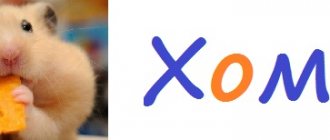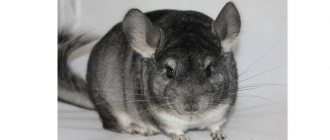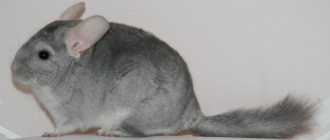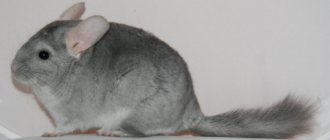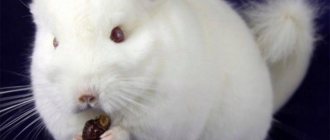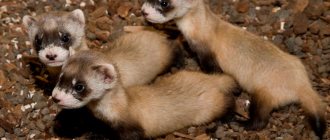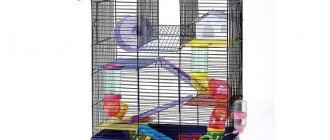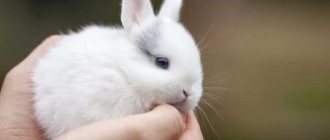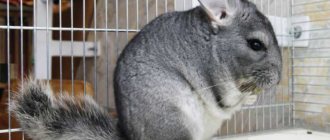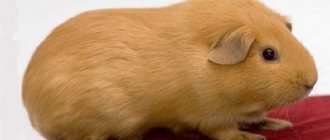- home
- Chinchilla
- Character and features
03/25/2019 There is a generally accepted opinion that the only chinchilla color is gray. However, this is not the case. For decades, breeders have been trying to develop fluffies with interesting colors. This article contains useful information about what colors of chinchillas can be found in nurseries.
Varieties of chinchillas
These animals come in two types, which differ in the size of the body and the size of the tail:
- Large short-tailed chinchillas (Peruvian) are native to Bolivia and some areas of the Argentine Andes. The fur of this chinchilla breed is so valuable that you will no longer see them in the wild. Today, such animals are raised only on farms. The short-tailed chinchilla has a strong body of 40 cm, weight 800 g. The tail is short with hard hair.
- Common, long-tailed (shore) chinchillas are still found in the Chilean Andes. They have a small body and an elongated tail covered with fur. Weight does not exceed 700 g.
Both chinchilla breeds are endowed with a gray color. Through selection of the Lesser Longtail, over 40 different colors of magnificent fur coats have appeared.
Angora chinchilla
The Royal Angora Chinchilla is a subspecies of the long-tailed chinchilla. Interestingly, it was not specifically bred. It was nature itself that gave us an animal with such a beautiful long coat.
The first rodents with this mutation were noticed in the 60s of the last century. However, the standard was described in 2001. Breeding the subspecies is extremely difficult. A pair of Angoras is likely to give birth to ordinary babies with short hair. Therefore, breeding such rodents requires high professionalism when selecting pairs.
Angora has a long silky coat, which is decorated with a luxurious tail. Another distinctive feature is the long fur on the head and paws. The muzzle is flattened, so these chinchillas have another “folk” name - Persian. The rarest individuals have the colors of black velvet, blue diamond, and violet.
Angora chinchilla is the most expensive. The cost of one copy can be several thousand dollars. The fur is so valuable that the high cost of the animal has been maintained for several decades.
Dwarf chinchillas
A natural genetic mutation caused the birth of mini chinchillas with a small body, short legs and a bushy tail. Weight does not exceed 300 g.
The dwarf chinchilla produces cubs of the same size as those of normal females. The miniature mother has a hard time giving birth. Often newborns do not survive. During pregnancy, the female is under the supervision of specialists. The colors of these cute fluffies can be varied.
Re: Angora+ 100% carrier=?
1. 50/50 and 2. not recommended, you can get just an angora, but you will get a deterioration in quality traits, as when breeding two recessives. Angoras are not yet a stable mutation, there are few high-quality Angoras, so it is recommended to breed Angoras with a high-quality carrier and pass the Angora babies through fur standards. It depends on what your goal is - commercial - just selling some Angoras, or selection - improving the quality of chinchillas from your nursery
Color options
In the wild, animals have many enemies. An inconspicuous and dim grayish fur coat is one of the shields. Rodents are less noticeable against the background of rocks.
Since people became interested in animals, white, black and beige breeds have been brought into the world. The result of many years of breeding research is rare colors. Today it is difficult to imagine that nature originally endowed this fluffy with only one color.
The entire palette of fur coats can be divided into the following groups:
- gray or agouti, which are considered standard;
- white with varying saturation or an admixture of pink, beige;
- brown or pastel, available in all colors, including chocolate;
- black with varying degrees of saturation;
- original fur coats in purple, sapphire and pink colors.
Animal colors are:
- Dominant, which are visible from birth.
- Recessive, when the rodent is only a carrier of the gene that is responsible for a certain fur color.
For breeding work, it is important to know what recessive color a rodent has.
Standard gray
Gray chinchillas exist in nature and in captivity.
There is a division by shade and depth:
- light;
- average;
- dark;
- moderately dark;
- extra dark.
This is the native color of wild chinchillas and their ancestors. Darker color on the back. The sides are light, the belly is snow-white. Color distribution on the hair: from gray-blue at the base to black at the crown.
What distinguishes individuals with gray colors is their health. They begin to bear offspring early. You can cross with any subspecies. The fur is pleasant and soft to the touch.
Light
A light gray fur coat with a silver tint looks very impressive. In such animals you can see a light shirt-front, abdomen, and paws.
Average
It is considered the typical and most common color. The body is a uniform gray color, lighter on the belly, chest and paws.
Dark
Gray fur with a blue tint and lighter coloring on the belly and chest makes rodents stand out from the general gray mass.
Moderately dark
Such animals have a dark gray coat that turns into spectacular ash on the paws, face and sides. Their belly is bluish-white.
Extra dark
Many fans have charcoal-gray chinchillas with light sides and chest. Their bellies are light beige.
Breeds with white fur
White chinchillas look elegant and representative. They have their own nuances.
White Wilson
Rodents, which are called white Wilson, are “dressed” in a white coat with possible admixtures of grayish or beige colors:
- Silver mosaic. The animal has a white fur coat with a silvery tint and dark fur on the head and base of the tail.
- Light mosaic. Rodents have light gray spots on a pure white coat. The scruff and ears are dark gray.
White chinchillas are not uncommon in nurseries. Breeders are willing to raise it, the color is in demand
Albino
Animals are not identified as a separate breed. An albino is an animal that lacks color pigment at the genetic level. Has milky fur and red eyes.
White Lova
A representative of an interesting variety of chinchillas is the White Lova. He has a white coat with a cream tint. Beautiful eyes the color of dark ruby.
White velvet
Rodents are carriers of a pleasant light velvet coat, which can be beige or silver. It is distinguished by expressive gray spots on the front legs and head.
White-pink
The milky coat of the rodent, which has black eyes and pinkish ears, produces a stunning effect. An individual with a pink back looks even more interesting.
Re: Angora+ 100% carrier=?
How do you understand passing through fur standards? If I understood correctly, then children from two Angoras should be placed with a fur standard? That is, essentially in a circle - two Angoras gave birth to Angora puppies, and they are mated with fur standards, the puppies born (if Angoras are born, and as I understand it as you wrote the answer to the first question, the chances are 50 to 50) then they can be mated with the other angora, and those born from this pair should also be raised to the fur standard? And the line should not be related? And if a pair of Angora + fur standard, then the probability is 50/50 or an Angora or fur standard will be born carrying CPA? Or can ordinary puppies be born, but with a carrier state?
And another question: if, for example, an angora is born from a pair of angora + angora, it is mated with a fur standard, and not an angora is born, but a carrier, then in what % ratio will it be a carrier?
Animals with beige color
Beige chinchilla (pastel) may have variations in shades. The older the animal, the darker its coat will be. It can be red, beige, brown. Animals are allowed to crossbreed.
Beige homozygous
Homobeige rodents with uniformly colored light beige fur have pink ears. The fur has no shading zoning; single hairs with dark “tops” are acceptable.
Heterobeige
Heterobeige, on the contrary, has uneven color. The entire fur is beige, and the undercoat and ends of the hairs are dark brown.
A heterobeige chinchilla with yellowness indicates a deterioration in breed qualities.
When choosing an animal, you must definitely consider the color line between the belly and the rest of the body.
Beige Tower
An animal with a coat color ranging from light to dark beige in combination with a brown ornament on the back looks intriguing.
Wellman's beige
A gentle little animal with light beige fur, delicate light ears and, as a contrast, black beady eyes.
Sullivan's Beige
The rodents that bear such a beautiful name have a rich beige coat and red eyes.
Brown velvet
These types of chinchillas have beige fur as a base, and their back and head are chocolate. The abdomen is sand-colored, sometimes almost white.
Ebony breed
The main difference between this chinchilla breed is not the color, but the quality of the fur. It shines extraordinarily and shimmers in the light. The color palette can be varied.
Homoebony
Black ebony is a rare type of color. The animals have a coal-black coat and black eyes. The second name for animals is charcoal.
Heteroebony
The shiny dark coat of heteroebony rodents combines two palettes: black and gray. Both options are great and eye-catching at exhibitions.
White ebony
There are chinchillas with a shining snow-white coat, which is given a special charm by black coating at the ends of the hairs. The paws, head and beginning of the tail can be gray or beige.
Angora+ 100% carrier=?
Hello. I think that my question applies more to guards than to beginners because not every beginner understands colors and genetics
)
I'm actually one of the newbies
)
If there are two chinchillas in a pair, one of which is a high-quality Angora, the second is a 100% carrier, what is the probability of giving birth to Angora puppies approximately in percentage terms?))
If there are both Angoras in a pair, how high is the 100% chance that the puppies will also be born Angoras?))
The color itself is not so important, only the angora mutation itself is interesting
) I’m a curious lady, and I’m asking purely out of curiosity, because I’m crazy about angoras)
Breeds of chinchillas with dark fur coats
Among the homoebony with rich black fur, the “black velvet” breed is distinguished.
Black velvet
The contrast of black and white is always mesmerizing. Fluffies with black fur on the body and tail combined with a light belly look amazing. The clearer the border of contrasts, the more valued the breed is.
The variety was bred in the 60s of the last century. It is believed that dark fur indicates the high quality of the breed. Black Velvet is distinguished by its markings: light stripes on its paws, charcoal mask, darkened fur on its head. The older the animal, the more clearly the breed characteristics are expressed. Breeders warn: the gene is lethal. Crossing “velvet” animals is prohibited. This will end badly for the mother and cubs.
Rare breeds
The most expensive chinchillas have a rare and amazing color. Breeders have developed interesting breeds of animals that cause genuine delight.
Violet
The fabulous light lilac fur of the body contrasts with the white belly. There is a purple impurity on the nose and ears.
The lavender color is passed on through the first and second generations. Rodents become sexually mature late. The ability to produce offspring occurs by one and a half years.
Sapphire
Bluish-gray or light blue fur with a graphite veil in combination with a white belly and pink ears looks simply amazing. The eyes are shiny black. Sapphires are one of the most expensive and sought after chinchillas.
Color appears by 7–8 months. It is better to purchase younger rodents with a declared sapphire color in specialized nurseries.
Blue Diamond
Pedigree chinchillas with light blue fur, a metallic tint and a dark pattern on the ridge and head are more valuable than sapphire ones.
White and pink diamond
Animals with a pearl coat and a shade of rose are considered rare. Ears are harmonious pink.
Animals have a lethal gene, so they cannot be paired together. They will make an excellent pair with rodents of other coat colors.
Re: Angora+ 100% carrier=?
Everything is much more complicated - I'm from the USA. This is one of the reasons why I became interested in Angoras. There is actually a monopoly on angora here, a farm from Texas. In fact, they only breed them, but do not sell them in the USA, only abroad. That's why I thought, maybe it's worth doing. Bring pairs of 10 Angoras, from “our” countries, carriers of colored and Angora quality, fur standards, etc. Only for this, you initially need to sort everything out, form pairs, correctly, so as not to spoil this beauty, but on the contrary, to increase it. Since a standard Angora here costs 2.5 thousand dollars, buying it in Russia or Ukraine, as you understand, is much cheaper (I mean high-quality, not similar. Yes, initially it’s quite expensive because our Angoras are not cheap either, but in a year, one and a half, if you are naturally lucky and form pairs competently, it is quite possible to “recoup your investment.”
As I understand it, in my case the most win-win option is angora + fur standard, and angora + rare colored carriers, since such tails are not cheap either (extra dark costs $250, regular without carrier, violet and sapphire $300-350, brulee for $500, etc., of course with carrier material and velvet ones are many times more expensive). That is, in essence, I want to combine business with pleasure, hobbies and income).
Therefore, for now I’m delving into the essence and being interested, because I’m used to being well prepared before doing or doing anything.
Last edited by Kalu4ka; 08/08/2015 at 18:25.
Source
Crossing chinchillas
The variety of colors is a boon for skilled breeders. The process of crossing is very exciting, since there is always the possibility of the manifestation of a recessive gene of one of the parents in the offspring.
There is a serious limitation when making a pair. You cannot combine two lethal genes: white and black. This will lead to the death of newborns. The female may also die during the period of bearing babies.
To successfully crossbreed rodents, breeders are issued animal passports. The document officially states which genes the pet is a carrier of. The possible color of the cubs is calculated using a color calculator.
Re: Angora+ 100% carrier=?
Kalu4ka
, Angora + Angora = Angora (all children) Angora + carrier of Angora = Angora or 100% carriers of Angora (in this case, 50/50, only Angoras can be born, or maybe only carriers, depending on your luck) Carrier of Angora + carrier of Angora = Angora , or angora carriers, or Angora standards + standard = all children 100% angora carriers The most correct option is to seat angoras with standards, and the resulting carriers with carriers. Animals must not be related.
